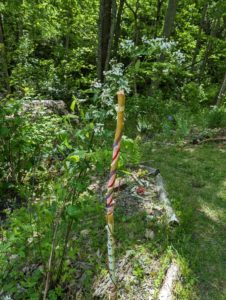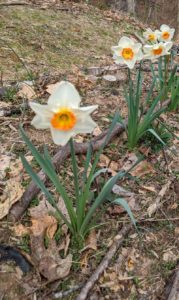By Margie Royal
If you are wondering what Electroculture is: scroll down to the first entry of this blog which was posted in April 2023.
February 2024
I never added a conclusion to my Electroculture Experiment. Now that it’s February 2024, the conclusion is long overdue but here it is: Electroculture works!
Last summer I had an amazing yield of blueberries from mid-June to early September. In addition, the two master blueberry plants have shot up babies, some of which I successfully was able to relocate to other areas of the yard. Blueberry bushes are also beautiful in the fall. The leaves turn a deep shade of red in autumn. I am very happy to have them for their fruit and fall beauty.
I froze a lot of the berries, and it was so nice to have them in a cobbler or in muffins throughout the winter. This March I will be taking a jam-making class so if I have another great yield of berries this year, I may try to make some blueberry jam.
Since copper wire is so expensive, last year I cut up old Christmas lights that I was keeping just for the tiny bulb replacements for a newer string. Most of the bulbs were gone or burned out on the old string, so I plugged in one end and put it in the ground, then wound the string to the top of the stick. I made another cut to expose the wire to the air. The blueberry bushes definitely liked the old Christmas light wire!
I will definitely be continuing using electroculture in my gardens in 2024.
A good site to follow for ideas and teachings about the origin of this practice is Cultivate Elevate.
HAPPY GARDENING!
July 2023
Now that July has arrived, I am starting to see the blueberries ripen up on the hill. Still no sign of a bear, thank goodness! The copper wire twined around large sticks near the blueberry bushes certainly has done no harm. In fact, it seems to have stimulated the large bushes to send out runners and start new plants a few feet away from the mother plant.
That’s something I haven’t seen in the four years I have lived on the property.
I’ll transplant these babies in a sunny spot where the soil stays a bit on the moist side, which I have read that blueberry plants supposedly prefer.
Is this new growth due to electroculture?
Maybe.
The experiment continues!
June 2023
May has always been a month of lush growth. My flower garden is flourishing. The blueberry bushes on the hill look like they will provide quite a yield this year so long as the bears don’t come to feast on them.
The copper wires twined around decorative walking sticks I made several years ago have certainly added a nice touch to the garden this year.
I am still not ready to say electroculture is responsible for all the lush growth in my gardens this year. The real test will be in July and August when the heat arrives. And if the tomatoes and zucchinis provide a good yield.
Because I want my garden to convince me that electoculture works, I have resisted watching any more videos or reading any more blogs on the subject. But I do remember one thing I read when I first was introduced to the idea of electroculture: that animals can sense the energy and are drawn to it. That teaching came to mind in May when, to my delight, I discovered a box turtle in one of the hillside garden beds. It’s a rare sighting!
Maybe there is something to electroculture after all.
May 2023
Since I am conducting an Electoculture Experiment, I’ve stayed away from watching anymore videos or reading books on the subject. I want my garden to convince me that coiling copper wire around a stick stimulates the soil and helps create healthy plants. I can accept the hypothesis that the copper wires conduct the natural energies of the earth and atmosphere and stimulate the soil to create an environment where plants will thrive. But I want my plants to show me that it works. After all, these days we are finding out that a lot of what we’ve blithely accepted as truth isn’t true at all. So, I consider myself guardedly open-minded to the idea of electroculture. Let my plants show me the proof that they like the newly added sticks and copper wires.

It’s early May 2023 and the blackberry bush is in bloom near a painted stick twined with copper wire.
And I have to say, whether it is just the weather this year, or the fact that I have been spending so much time in the garden, I am being rewarded by some spectacular dianthus popping up in a range of colors from magenta to pink to white.
Native irises which have never bloomed, are boasting multiple buds in several areas of the backyard. The ones in the front yard which don’t have copper wire near them have no blooms at all. Just like last year. They’ve multiplied but not bloomed. But maybe they don’t like the spot where they are planted…
The wild blueberry bushes on the hill behind the house were one of the first plants to have copper wires installed near them. Last year’s yield was pitiful. This year, the bushes are just beginning to form lots and lots of little berries. And it looks like the blackberry bush I planted last year is going to yield a fine crop of berries this summer.
The onions I planted have already sprouted.
So, are these signs of garden health due to electroculture? Or are the plants liking my increased attention to them and good weeding of their turf? It’s early in the growing season yet. As I said when I began the experiment last month, I will let my garden convince me that electroculture works. If I compare this spring to last year, there’s a noticeable difference.
But it’s too early yet to draw a conclusion…
April 2023
I sometimes watch garden videos on YouTube. I like to see how people have designed their gardens and often get ideas for my garden by watching planting tips. So, one garden video that popped up recently was about electroculture.
What was that?
I was intrigued.

My garden started off strong in February with the appearance of these beauties. Will electroculture help my garden thrive this year? Photo by Margie Royal
I learned that electroculture is said to be a way of utilizing the Earth’s natural magnetism. A copper wire is coiled around a stick which is then anchored into the soil. The wire at the top of the stick is like an antenna. The copper conducts low-level electrical currents which are said to enliven the soil and stimulate plant growth. It is said to reduce the need for fertilizers and toxic pesticides. And, if you’re growing vegetables or fruits, electroculture practitioners say you’ll be amazed at the increased yields.
Advocates also say their plants are healthier and more resistant to pests and disease.
Does it work?
Two weeks ago, I decided to test it out.
I bought some copper wire and installed several sticks coiled with the copper wire in several places in my garden. One is near a blueberry bush and a few others are in my perennial garden.
I’ll install others when I plant my tomato plants after Mother’s Day.
It’s early April and a week after a copper wire stick was installed near them, I have irises getting ready to bloom. That’s early! They usually bloom in late April or early May. And last year the irises that are near the stick didn’t bloom at all…
Maybe there is something to this after all.
But I’ll let my garden convince me. I’ll post results throughout the summer.
Here’s the excellent video that inspired my interest in electroculture.